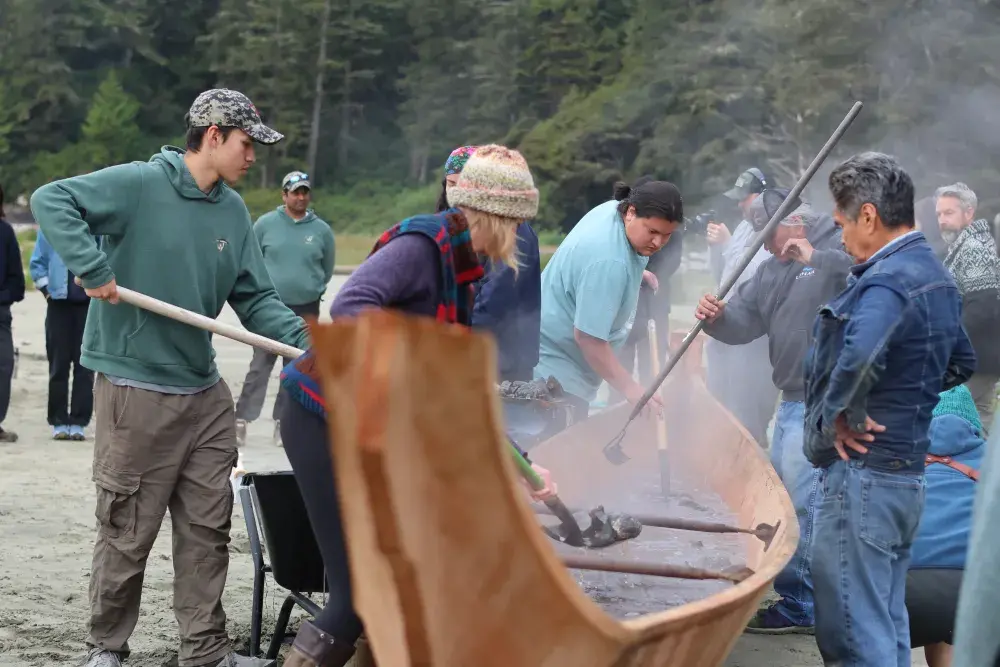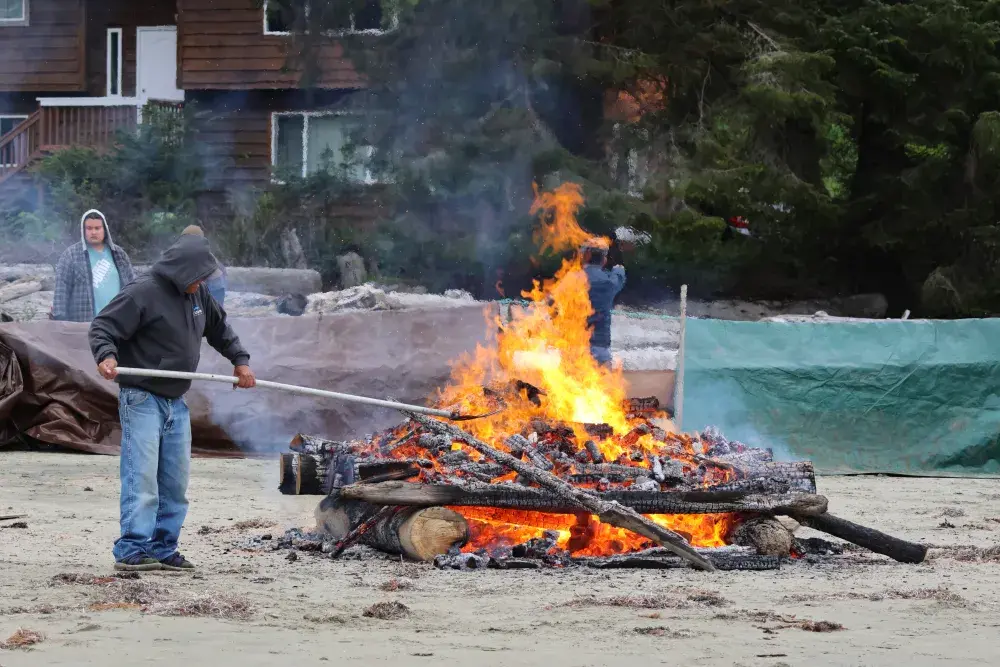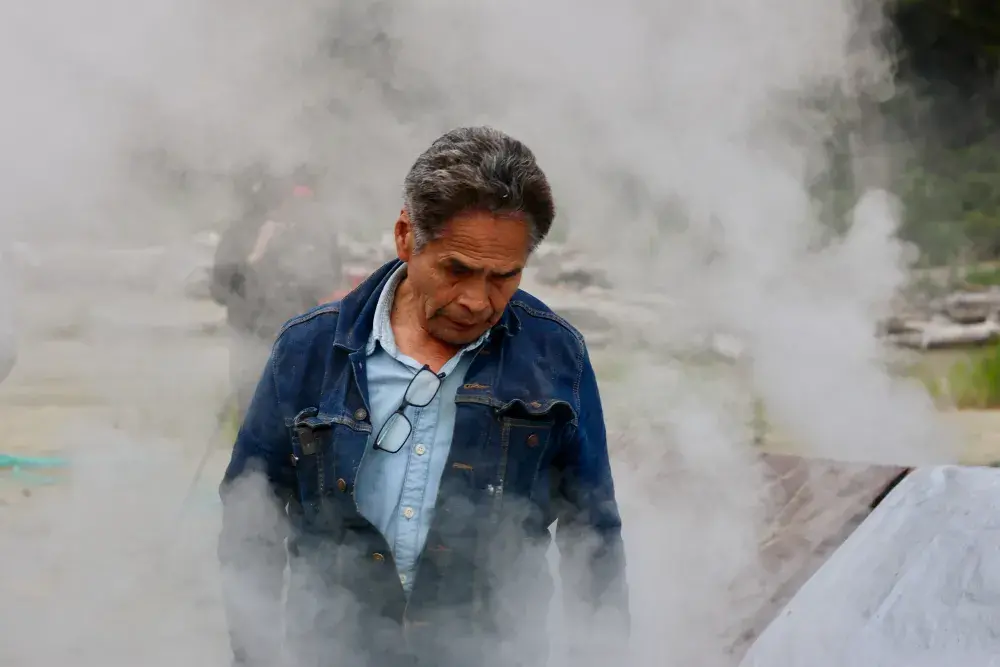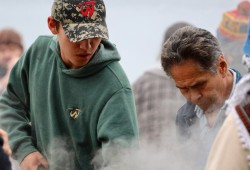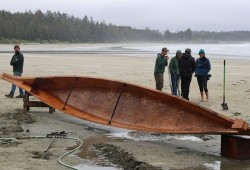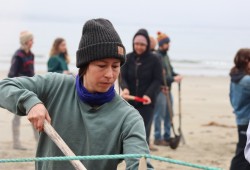The rocks were hot enough to use by about 7:30 a.m. on the muggy May 15 morning at Esowista on Long Beach.
With confidence and ease, Tla-o-qui-aht canoe carver Joe Martin instructed about a dozen shovel-ready helpers to shuttle the 150 stones from the fire to the cedar canoe holding about four inches of salt water. Like stepping into a time machine, the distinct hissing sound of steam and enchanting scent of smoky cedar seemingly transported the group back to a different era.
“People have been doing this kind of thing for a long, long time. Canoe making is something everyone learned back in the former days. Every household would have had canoe builders and house makers,” said Martin.
After most of the rocks were plopped in the canoe, they wrapped it snug with several tarps for just under an hour to steam.
“The heat from the water and the rocks make the (wood) soft enough so you can bend it,” Martin explained, adding that in the former times they used a long, tapered wedge to lift the bow and stern so the canoe opens.
“Instead of that, I have a hydraulic jack on the back and we’ll get another little jack on the front. It will lift it and open it just enough. Sometimes, I’ll go beyond what I would like then I’ll let the canoe relax for a day or two then it comes back a little bit. That way it takes all the stress out of it. Then we put in the seats. If we leave it at the widest we can make then when we go in the water it’s always under stress and it can crack in the water,” he continued.
For Huu-ay-aht Warrior Andrew Clappis, 17, participating in the canoe steaming was a wonderful surprise.
“I didn’t think I’d be attending a canoe steaming this week. It’s so cool,” said Clappis. “Just learning how to do it now (is important) so we can teach the next generation.”
Honouring the tree
Four Nuu-chah-nulth apprentices Terrell Lamb, Valleen Jules, Tsimka Martin and Thomas Zarelli worked with Martin and his brother Carl over the past 70 days to get the canoe to the steaming stage. Martin told the Ha-Shilth-Sa he was honoured to have his daughter, Tsimka, take part in the traditional practice.
“A really empowering part of this process was actually selecting and falling and carving the canoes in the forest,” said Tsimka.
“Selecting the tree and doing a ceremony on the carving site was really special. It feels very different than if we were working in a gravel yard and a logging company brought us a log,” she said.
Over the course of two months, the apprentices camped in the woods within TFN Tribal Parks territory, working on the 600- to 700-year-old cedar they selected to carve two canoes.
Martin emphasized the importance of harvesting resources in the fall and winter, instead of the summer and spring when birds are nesting.
“That was the very first thing my grandfather taught me about this. We really disrupted the natural environment by just cutting wood down any old time of year all year long,” said Martin.
With the help of WestCoast Wild Zipline Adventures, the canoe carving team rigged a zipline to remove the canoes from the forest and transport them to the beach for steaming.
Funded by Tla-o-qui-aht First Nation (TFN), the goal of the canoe project is for Nuu-chah-nulth youth to reclaim their cultural practices and reconnect with the land.
“The revitalization of our culture is amazing to see,” said TFN Capacity Building Co-ordinator Norine Messer. “These are the things that will bring us back. It’s an essential part of healing, the reclaiming and practice of traditional teachings.”
Once the work is finished on both canoes, they will be stored in either Opitsaht or Ty-Histanis to be used for youth programming like: harvesting, canoe races and family picnics.
“We will keep them together for easy access and regular use,” Messer said.

